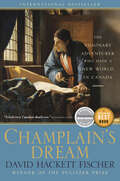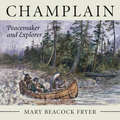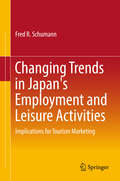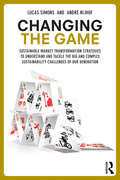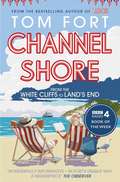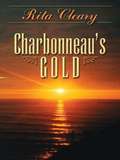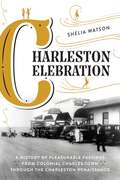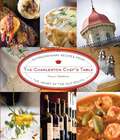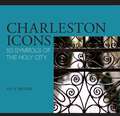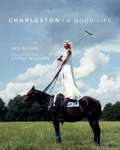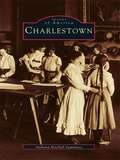- Table View
- List View
Champions For Change: How the Mississippi State Bulldogs and Their Bold Coach Defied Segregation (Sports)
by Kyle VeazeyMississippi State dominated Southeastern Conference basketball in the late 1950s and early 1960s. Starting in 1959, the team won four conference titles over five seasons. Yet despite earning their way, the Bulldogs remained routinely absent from NCAA tournaments. Amid a climate of fierce segregation, Mississippi refused to allow its collegiate teams to compete with integrated programs. In 1963, one team determined to compete on the national stage made state history. Led by beloved coach Babe McCarthy and supported by university students and administration, the Bulldogs made a daring and furtive trip to play Loyola's integrated team in the national tournament. Now, sports journalist Kyle Veazey vividly recounts the amazing journey of a team that refused to be hindered by the status quo.
Champlain
by Christopher Moore Francis Back"One July day four hundred years ago, Samuel de Champlain stepped out of a small boat at Quebec and began a great adventure." So begins Christopher Moore's riveting account of the life of the extraordinary, daring "father of New France." Samuel de Champlain helped found the first permanent French settlement in the New World; he established the village that eventually became the great city of Quebec; he was a skilled cartographer who gave us many of our first accurate maps of North America; he forged alliances with Native nations that laid the foundations for vast trading networks; and as governor, he set New France on the road to becoming a productive, self-sufficient, thriving colony. But Champlain was also a man who suffered his share of defeats and disappointments. That first permanent settlement was abandoned after a disastrous winter claimed the lives of half the colonists. His marriage to a child bride was unhappy and marked by long separations. Eventually Quebec had to be surrendered temporarily to the English in 1629. In this remarkable book, illustrated entirely with paintings, archival maps, and original artifacts, Christopher Moore brings to life this complex man and, through him, creates a portrait of Canada in its earliest days. Champlain is illustrated with archival maps and paintings. Additional artwork has been provided by Francis Back.From the Hardcover edition.
Champlain's Dream
by David Hackett FischerIn this sweeping, enthralling biography, acclaimed Pulitzer Prize–winner David Hackett Fischer magnificently brings to life the visionary adventurer who has straddled our history for 400 years. Champlain’s Dream reveals, with rare immediacy and drama, the story of a remarkable man: a leader who dreamed of humanity and peace in a world riven by violence; a man of his own time who nevertheless strove to build a settlement in Canada that would be founded on harmony and respect. With consummate narrative skill and comprehensive scholarship, Fischer unfolds a life shrouded in mystery, a complex, elusive man among many colorful characters. Born on France’s Atlantic coast, Samuel de Champlain grew up in a country bitterly divided by religious wars. But, like Henry IV, one of France’s greatest kings whose illegitimate son he may have been and who supported his travels from the Spanish Empire in Mexico to the St. Lawrence and the unknown territories, Champlain was religiously tolerant in an age of murderous sectarianism. Soldier, spy, master mariner, explorer, cartographer, and artist, he maneuvered his way through court intrigues in Paris, supported by Henri IV and, later, Louis XIII, though bitterly opposed by the Queen Regent Marie de Medici and the wily Cardinal Richelieu. But his astonishing dedication and stamina triumphed…. Champlain was an excellent navigator. He went to sea as a boy, acquiring the skills that allowed him to make 27 Atlantic crossings between France and Canada, enduring raging storms without losing a ship, and finally bringing with him into the wilderness his young wife, whom he had married in middle age. In the place he called Quebec, on the beautiful north shore of the St. Lawrence, he founded the first European settlement in Canada, where he dreamed that Europeans and First Nations would cooperate for mutual benefit. There he played a role in starting the growth of three populations — Québécois, Acadian, and Métis — from which millions descend. Through three decades, on foot and by ship and canoe, Champlain traveled through what are now six Canadian provinces and five American states, negotiating with more than a dozen Indian nations, encouraging intermarriage among the French colonists and the natives, and insisting, as a Catholic, on tolerance for Protestants. A brilliant politician as well as a soldier, he tried constantly to maintain a balance of power among the Indian nations and his Indian allies, but, when he had to, he took up arms with them and against them, proving himself a formidable strategist and warrior in ferocious wars.Drawing on Champlain’s own diaries and accounts, as well as his exquisite drawings and maps, Fischer shows him to have been a keen observer of a vanished world: an artist and cartographer who drew and wrote vividly, publishing four invaluable books on the life he saw around him. This superb biography (the first full-scale biography in decades) by a great historian is as dramatic and richly exciting as the life it portrays. Deeply researched, it is illustrated throughout with 110 contemporary images and 37 maps, including several drawn by Champlain himself.
Champlain's Dream: The Visionary Adventurer Who Made A New World In Canada
by David Hackett FischerIn this sweeping, enthralling biography, acclaimed Pulitzer Prize–winner David Hackett Fischer magnificently brings to life the visionary adventurer who has straddled our history for 400 years. Champlain’s Dream reveals, with rare immediacy and drama, the story of a remarkable man: a leader who dreamed of humanity and peace in a world riven by violence; a man of his own time who nevertheless strove to build a settlement in Canada that would be founded on harmony and respect. With consummate narrative skill and comprehensive scholarship, Fischer unfolds a life shrouded in mystery, a complex, elusive man among many colorful characters. Born on France’s Atlantic coast, Samuel de Champlain grew up in a country bitterly divided by religious wars. But, like Henry IV, one of France’s greatest kings whose illegitimate son he may have been and who supported his travels from the Spanish Empire in Mexico to the St. Lawrence and the unknown territories, Champlain was religiously tolerant in an age of murderous sectarianism. Soldier, spy, master mariner, explorer, cartographer, and artist, he maneuvered his way through court intrigues in Paris, supported by Henri IV and, later, Louis XIII, though bitterly opposed by the Queen Regent Marie de Medici and the wily Cardinal Richelieu. But his astonishing dedication and stamina triumphed…. Champlain was an excellent navigator. He went to sea as a boy, acquiring the skills that allowed him to make 27 Atlantic crossings between France and Canada, enduring raging storms without losing a ship, and finally bringing with him into the wilderness his young wife, whom he had married in middle age. In the place he called Quebec, on the beautiful north shore of the St. Lawrence, he founded the first European settlement in Canada, where he dreamed that Europeans and First Nations would cooperate for mutual benefit. There he played a role in starting the growth of three populations — Québécois, Acadian, and Métis — from which millions descend. Through three decades, on foot and by ship and canoe, Champlain traveled through what are now six Canadian provinces and five American states, negotiating with more than a dozen Indian nations, encouraging intermarriage among the French colonists and the natives, and insisting, as a Catholic, on tolerance for Protestants. A brilliant politician as well as a soldier, he tried constantly to maintain a balance of power among the Indian nations and his Indian allies, but, when he had to, he took up arms with them and against them, proving himself a formidable strategist and warrior in ferocious wars.Drawing on Champlain’s own diaries and accounts, as well as his exquisite drawings and maps, Fischer shows him to have been a keen observer of a vanished world: an artist and cartographer who drew and wrote vividly, publishing four invaluable books on the life he saw around him. This superb biography (the first full-scale biography in decades) by a great historian is as dramatic and richly exciting as the life it portrays. Deeply researched, it is illustrated throughout with 110 contemporary images and 37 maps, including several drawn by Champlain himself.
Champlain: Peacemaker and Explorer
by Mary Beacock FryerSamuel de Champlain has long been known as the founder of Quebec and as a tireless explorer. No one knows for sure where he was born or who he really was. Still, his career was packed with interesting details and his early life prepared him for greatness.Without Champlains own detailed records, the years 1600 to 1640 in Canada would be almost a mystery. Possibly Canadas first multicultural advocate, he dreamed of creating a new people from French and Aboriginal roots. However, his efforts to establish a colony encountered setbacks in France. Among his detractors was the powerful Cardinal Richelieu. Champlain was not of the nobility and thus was considered unfit for patronage.The explorers story is an exciting one, as he explored new territory, established alliances and understandings with Natives, waged war when necessary, and left behind a legend in the New World that lasts to this day.
Chance Particulars: A Writer's Field Notebook for Travelers, Bloggers, Essayists, Memoirists, Novelists, Journalists, Adventurers, Naturalists, Sketchers, and Other Note-Takers and Recorders of Life
by Sara Mansfield TaberAn essential guide for writers on how to record and use rich detail to enliven their work.The goal of the writer is to live with the keenness of the foreigner. To experience, wide-eyed, the sensations aroused and the events offered up by peculiar surrounds and then to evoke them so brightly on the page that the reader, too, experiences the foreigner’s frisson. A time-honored way this is accomplished is through the keeping of a field notebook—through the faithful recording of the this-and-that of life; the atmospheres and incidents; the bells, the beer, the bread.Based on what accomplished nonfiction writer Sara Mansfield Taber learned in her many years of field notebook keeping, Chance Particulars is a unique and handy primer for writers who want to use their experiences to tell a lively, satisfying story. Often, writers try to turn their notes into a memoir, essay, travel piece, or story, only to find that they haven’t recorded enough of the concrete, sensory details necessary to create evocative description. To help writers overcome this problem, Taber has composed a true "field notebook for field notebook keepers." Enhanced by beautiful illustrations, this charming and comprehensive guide is a practical manual for anyone who wishes to learn or hone the crafts of writing, ethnography, or journalism.Writers of all levels, genres, and ages, as well as teachers of writing, will appreciate this useful tool for learning how to record the details that build vibrant prose. With this book in hand, you will be able to recreate times and places, conjure up intricate character portraits, and paint pictures of particular landscapes, cultures, and locales.
Chance Particulars: A Writer's Field Notebook for Travelers, Bloggers, Essayists, Memoirists, Novelists, Journalists, Adventurers, Naturalists, Sketchers, and Other Note-Takers and Recorders of Life
by Sara Mansfield Taber“A guide to paying attention to the concrete, sensory details of experience and the process of getting them down on the page.” —James Barilla, author of My Backyard JungleBased on what accomplished nonfiction writer Sara Mansfield Taber learned in her many years of field notebook keeping, Chance Particulars is a unique and handy primer for writers who want to use their experiences to tell a lively, satisfying story. Often, writers try to turn their notes into a memoir, essay, travel piece, or story, only to find that they haven’t recorded enough of details necessary to create evocative description. To help writers overcome this problem, Taber has composed a true “field notebook for field notebook keepers.” Enhanced by beautiful illustrations, this charming and comprehensive guide is a practical manual for anyone who wishes to learn or hone the crafts of writing, ethnography, or journalism.Writers of all levels, genres, and ages, as well as teachers of writing, will appreciate this useful tool for learning how to record the details that build vibrant prose. With this book in hand, you will be able to recreate times and places, conjure up intricate character portraits, and paint pictures of particular landscapes, cultures, and locales.“At once a delicious read and the distilled wisdom of a long-time teacher and virtuoso of the literary memoir. Her powerful lessons will give you rare and vital skills: to be able to read the world around you, and to read other writers, as a writer, that is, with your beadiest conjurer’s eye and mammoth heart. This is a book to savor, to engage with, and to reread, again and again.” —C. M. Mayo, author of Miraculous Air
Chandler
by Jody A. Crago Mari Dresner Nate MeyersChandler is located 20 miles southeast of Phoenix and has been the home of innovative, forward-thinking people for many decades. As Phoenix began to grow in the late 19th century, a young veterinarian decided to aquire several acres of the surrounding land. Dr. Alexander J. Chandler took a few business gambles with his new acquisition, and the 18,000 acres known then as Chandler Ranch were soon split into lots and sold as the new town of Chandler. Once the town was established in 1912, Dr. Chandler relied on industrial agriculture and the new, lavish San Marcos Hotel to attract new residents. Later, Dr. Chandler brought Frank Lloyd Wright to redesign downtown and build a new hotel. During World War II, several families and businesses came to the area because of the new Williams Air Force Base. Following the war, high-tech businesses and bioscience firms created a new economy in Chandler, which led to a modern patchwork of people who represent Chandler today.
Changing Gears: A Distant Teen, a Desperate Mother, and 4,329 Miles Across the Transamerica Bicycle Trail
by Leah DayWhat happens when a mother and her 16-year-old son drop everything to bike across the country? On the TransAmerica Bicycle Trail, they struggle up hills in the pouring rain, they feel soreness in muscles they didn&’t know they had, and they learn more about each other than they ever knew before. When licensed clinical therapist and self-proclaimed &“reluctant adventurer&” Leah Day felt herself drifting from her son, Oakley, she decided to make a drastic play to reconnect. In this memoir chronicling the journey of a lifetime, Leah and Oakley find that if they can push themselves to accomplish physically exhausting and emotionally taxing milestones on a bike, they are capable of anything!
Changing Trends in Japan's Employment and Leisure Activities: Implications for Tourism Marketing
by Fred R. SchumannThis book reviews employment and leisure trends in Japan from the post-war era to the present. In addition, it also examines how these trends will affect tourism destinations and businesses that rely heavily on Japanese overseas tourism. Topics that are of particular interest to readers include the most current Japanese employment and leisure data and how the data compares with the earlier, postwar era that made up the boom-years of Japanese overseas travel. The latest data provides insight into how today's working and living conditions in Japan impact overseas travel expenditures today. Readers, ranging from academics to business practitioners, will benefit from the book that provides the latest information that can be used in a practical manner to assist tourism-related businesses and organizations meet the current and future needs of the Japan overseas travel market.
Changing the Game: Sustainable Market Transformation Strategies to Understand and Tackle the Big and Complex Sustainability Challenges of Our Generation
by Lucas Simons Andre NijhofWe are at the beginning of the sustainability era. The biggest challenge of our generation is to reach the Sustainable Development Goals. For this we must be willing to understand and change the root causes that create these challenges in the first place. The system itself needs to change. But how to do that? This ground-breaking book Changing the Game reveals the missing insights and strategies to actually achieve system change. The authors Lucas Simons and André Nijhof bring decades of real life and academic experience, and state that most of the sustainability challenges are actually caused by the same system failures, every time. Therefore, the way to accelerate and manage system change is also similar every time – if you know where to look and how to act. The theory of sustainable market transformation and system change is described in a compelling and easy to understand eight-step approach applied to eight different sectors. The authors, together with respected sector experts, describe the drivers, triggers and dominant thinking in each of these sectors as well as the strategies needed to move towards higher levels of sustainability. This book is highly accessible and engaging, and is perfect for use by professionals, leaders and students for understanding how to move markets to a more sustainable future.
Channel Shore
by Tom FortThe English Channel is the busiest waterway in the world. Ferries steam back and forth, trains thunder through the tunnel. The narrow sea has been crucial to our development and prosperity. It helps define our notion of Englishness, as an island people, a nation of seafarers. It is also our nearest, dearest playground where people have sought sun, sin and bracing breezes. Tom Fort takes us on a fascinating, discursive journey from east to west, to find out what this stretch of water means to us and what is so special about the English seaside, that edge between land and seawater. He dips his toe into Sandgate's waters, takes the air in Hastings and Bexhill, chews whelks in Brighton, builds a sandcastle in Sandbanks, sunbathes in sunny Sidmouth, catches prawns off the slipway at Salcombe and hunts a shark off Looe. Stories of smugglers and shipwreck robbers, of beachcombers and samphire gatherers, gold diggers and fossil hunters abound.
Character, Ethics and Economics: British Debates on Empire, 1860-1914
by Peter CainThis book is an examination of the concept of ‘character’ as a moral marker in the later nineteenth and early twentieth centuries. Its main purpose is to investigate how the ‘character talk’ that helped to shape elite Britons’ sense of themselves was used at this time to convince audiences, both in Britain and in the places they had conquered, that empire could be morally as well as materially justified and was a great force for good in the world. A small group of radical thinkers questioned many of the arguments of the imperialists but found it difficult to escape entirely from the sense of moral superiority that marked the latter’s language.
Charbonneau's Gold: A Lewis & Clark Story
by Rita ClearyThe hardships were incredible. The duration of the trip overland and over the Rockies was much longer than expected. Some hope arrived with Charbonneau, who claimed he knew the way to the Pacific
Charles County
by Jacqueline ZillioxFaithful subjects of the English crown, Jesuits, and entrepreneurs first settled in Charles County in the early 1630s. The area quickly sprouted into Colonial-styled plantation life of distinct Southern charm. The currency of the day was tobacco, even for payment of taxes and doctor bills. Through the War of 1812 and the Civil War, the mainly agricultural economy of the county was devastated. But as time passed, plantations became farmsteads, Native American trails became roadways, and the railroad created new town centers, such as Waldorf and La Plata. In the earlier years, the county's self-sufficiency was strongly displayed when the public school system and fire departments were started through private donations. For most of its life, Charles County's only employer not associated with agriculture was the Indian Head Naval Proving Ground, now known as the Indian Head Division, Naval Surface Warfare Center. It is still ranked as the county's number one employer. Tobacco still reigned as the cash crop of choice until 2000.
Charles Darwin and the Voyage of the Beagle
by Ruth AshbyIn 1831, young adventurer and nature enthusiast Charles Darwin set sail on a remarkable five-year voyage that changed the study of biology forever.Award-winning author Ruth Ashby shares the story of Darwin's famous journey aboard the British navy ship, the Beagle, which led to the development of his theories of evolution and natural selection.This lively account follows the naturalist's exciting trip around the world—through seasickness, a life-threatening illness, and even an earthquake—as he explores South America, the Cape Verde Islands, Tahiti, and the Galapagos Islands. During his travels, Darwin meets Indigenous peoples and carefully collects and catalogs plants, fossils, birds, mammals, and insects. Darwin's observations of the distribution and diversity of plant and animal life ultimately leads to the development of his theories on evolution.Readers will be inspired by Darwin's transformation from talented but mediocre schoolboy into a remarkable scientist as they read about the revolutionary voyage that forever changed the world of biology.
Charles Darwin's Around The World Adventure
by Jennifer ThermesIn 1831, Charles Darwin embarked on his first voyage. Though he was a scientist by profession, he was an explorer at heart. While journeying around South America for the first time aboard a ninety-foot-long ship named the Beagle, Charles collected insets, dug up bones, galloped with gauchos, encountered volcanoes and earthquakes, and even ate armadillo for breakfast! The discoveries he made during this adventure would later inspire ideas that changed how we see the world. <p><p> Complete with mesmerizing map work that charts Darwin's thrilling five-year voyage, as well as "Fun Facts" and more, Charles Darwin's Around-the-World Adventure captures the beauty and mystery of nature with wide-eyed wonder.
Charles Kuralt's America
by Charles KuraltCharles Kurault takes a year-long trip across the United States, visiting well-known and out-of-the-way places alike. He describes the things he sees, the people he meets and his thoughts on it all.
Charleston Celebration: A History of Pleasurable Pastimes from Colonial Charles Town through the Charleston Renaissance
by Shelia WatsonA century before Boston became been the birthplace of the American Revolution, Carolina Colony was the birthplace of entertainment and leisure activities in Colonial America. Building a civilized city in the uncultivated New World was hard work, but Southern settlers made sure to leave time for life&’s lighter pursuits. Every aspect of the port city elicited pleasure, from the architecture to the magnificent parks and manicured gardens. Throughout the Civil War, Reconstruction, and the Great Depression, Charleston and other seaside towns along South Carolina&’s coast were fertile ground for art, music, and opportunity. It&’s no wonder the region has drawn famous characters for hundreds of years, from political leaders, George Washington, Thomas Heyward, Jr., and John C. Calhoun, to pirates, Stede Bonnet, Blackbeard, and Anne Bonny, and the artists, writers, musicians, and architects who ushered in the Charleston Renaissance in the twentieth century.Take a journey through Charleston&’s past with a look at the talented people and inspiring events that shaped the city and surrounding region into a cultural mecca of art, music, dance, and design. Each chapter features an itinerary for a walking or driving tour to help readers celebrate the lesser-known side of Charleston&’s entertaining past.
Charleston Chef's Table: Extraordinary Recipes from the Heart of the Old South (Chef's Table)
by Holly HerrickSignature recipes from greater Charleston’s top restaurants In recent years, Charleston, which hosts more than four million visitors annually, has matured into a world-class culinary destination. Now, The Charleston Chef’s Table allows locals and visitors alike to take a bit of the city’s incomparable flavor home, with profiles of more than sixty of the city’s best restaurants and a signature recipe from each. From roadside dives to upscale eateries, Southern to Chinese, Holly Herrick leaves no stone unturned as she winnows Charleston’s 1,500 restaurants down to her top picks. From fried chicken to sautéed duck livers, The Charleston Chef’s Table delivers all the goods that make Charleston such an exciting place to visit, live, and dine. Complementing the text are full-color photographs, as well as sidebars that highlight this Southern gem’s 300-year history.
Charleston Food Crawls: Touring the Neighborhoods One Bite and Libation at a Time (Food Crawls)
by Jesse BlancoSip and taste your way through Charleston. Charleston Food Crawls is an exciting culinary tour through the largest city in South Carolina. Taste the city&’s culinary history through its top-notch neighborhood restaurants and bars. Hit the Upper Peninsula for a day of breweries and barbeque galore. Just in town for the weekend? Take a stroll through King Street for quick bites and crafty sips. Experience where southern comfort food and zesty libations collide, and dig into Charleston one dish at a time.
Charleston History in Color: Photographs from the Civil War to Modern Days
by Mark R. Jones Lewis HayesCharleston Like It's Never Been Seen Hand-colored, vivid details bring these historic photographs to life like never before. Witness the beginnings of the sweetgrass basket tradition. See the bleak devastation on Meeting Street after the Civil War. Note intense contrast in blues and grays of prisoners captured at the Battle of Bull Run. Explore the Battery as it looked in the 1800s. And dazzle in the bright fashions of flappers at the dawn of "the Charleston" dance craze. Author Mark Jones and artist Lewis Hayes bring a new vision to Holy City history.
Charleston Icons: 50 Symbols of the Holy City (Icons)
by Ida BeckerCharleston Icons celebrates the Holy City through full-color photographs and evocative essays highlighting fifty of the best places, foods, buildings, institutions, and inventions that Charleston has to offer. From the four corners of law to sweetgrass baskets, the Spoleto Festival to shrimp, grits, and boiled peanuts, this book showcases what makes Charleston special.
Charleston: A Good Life
by Ned Brown Gately WillamsInspired by the legendary work of Slim Aarons, a photographic narrative tour of a beautiful, unique, historical city and the remarkable people who live there.Author Ned Brown kicks off the Good Life series with the story about what makes Charleston, South Carolina so desirable to its residents and the five million visitors who seek it out each year. This stunning coffee- table book features photographs by Gately Williams, whose work is regularly featured in Garden & Gun, Coastal Living, and other publications.With his signature ease, Brown profiles more than fifty “interesting Charlestonians, doing interesting things in a beautiful place.” Charleston: A Good Life highlights native Charlestonians and those who have made the southern Holy City their home during the past two decades. Some are wealthy, many not, but all enjoy the richness of a place that has been voted the best small city in the world by Travel + Leisure magazine.
Charlestown (Images of America)
by Anthony Mitchell SammarcoOriginally settled in 1629, Charlestown became well-known as the scene of the pivotal Revolutionary Battle of Bunker Hill, actually fought on Breed's Hill. Recovering from a devastating fire at the hands of the British soon after the battle, Charlestown went on to become a prosperous neighbor to Boston, eventually being annexed to the larger city in 1874. Today the city is enjoying a tremendous rebirth and the restoration of many of its important landmarks, such as the 1780 Warren Tavern.


